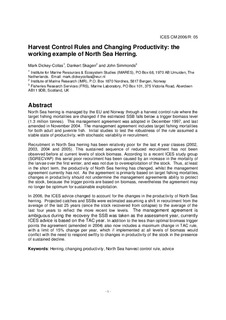| dc.description.abstract | North Sea herring is managed by the EU and Norway through a harvest control rule where
target fishing mortalities are changed if the estimated SSB falls below a trigger biomass
million tonnes). This management agreement was adopted in December 1997,
amended in November 2004. The management agreement includes target fishing mortalities
both adult and juvenile fish. Initial studies to test the robustness of the rule assumed
stable state of productivity, with stochastic variability in recruitment.
Recruitment in North Sea herring has been relatively poor for the last 4 year classes
2003, 2004 and 2005). This sustained sequence of reduced recruitment has not
observed before at current levels of stock biomass. According to a recent ICES study
SGRECVAP) this serial poor recruitment has been caused by an increase in the mortality
larvae over the first winter, and was not due to overexploitation of the stock. Thus,
the short term, the productivity of North Sea herring has changed, whilst the management
agreement currently has not. As the agreement is primarily based on target fishing mortalities,
changes in productivity should not undermine the management agreements ability to
stock, because the trigger points are based on biomass, nevertheless the agreement
longer be optimum for sustainable exploitation.
2006, the ICES advice changed to account for the changes in the productivity of North
herring. Projected catches and SSBs were estimated assuming a shift in recruitment
average of the last 25 years (since the stock recovered from collapse) to the average
four years to reflect the more recent low levels. The management agreement
ambiguous during the recovery the SSB was taken as the assessment year,
ICES advice is based on the TAC year. In addition to the less than optimal biomass
points the agreement (amended in 2004) also now includes a maximum change in TAC
a limit of 15% change per year, which if implemented at all levels of biomass
conflict with the need to respond swiftly to changes in productivity of the stock in the
sustained decline.
Keywords: Herring, changing productivity, North Sea harvest control rule, advice | en |
